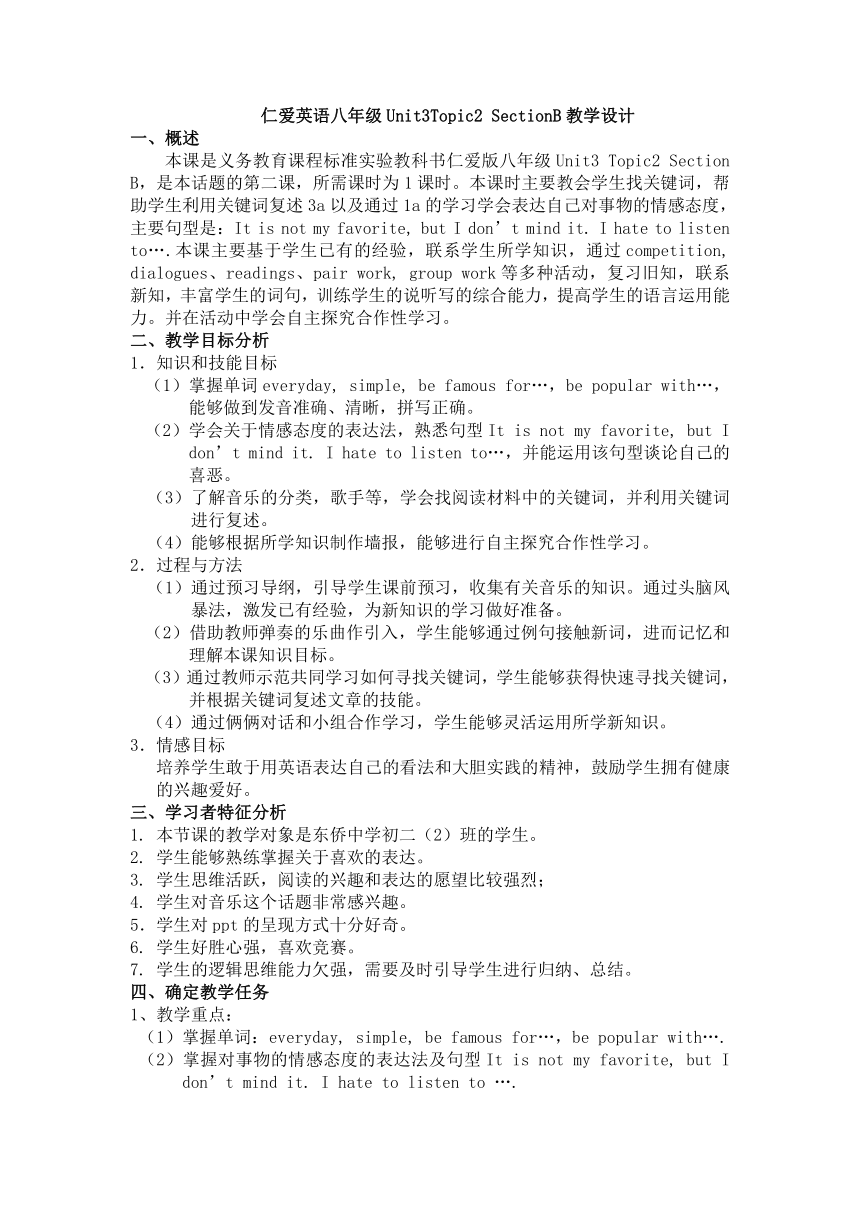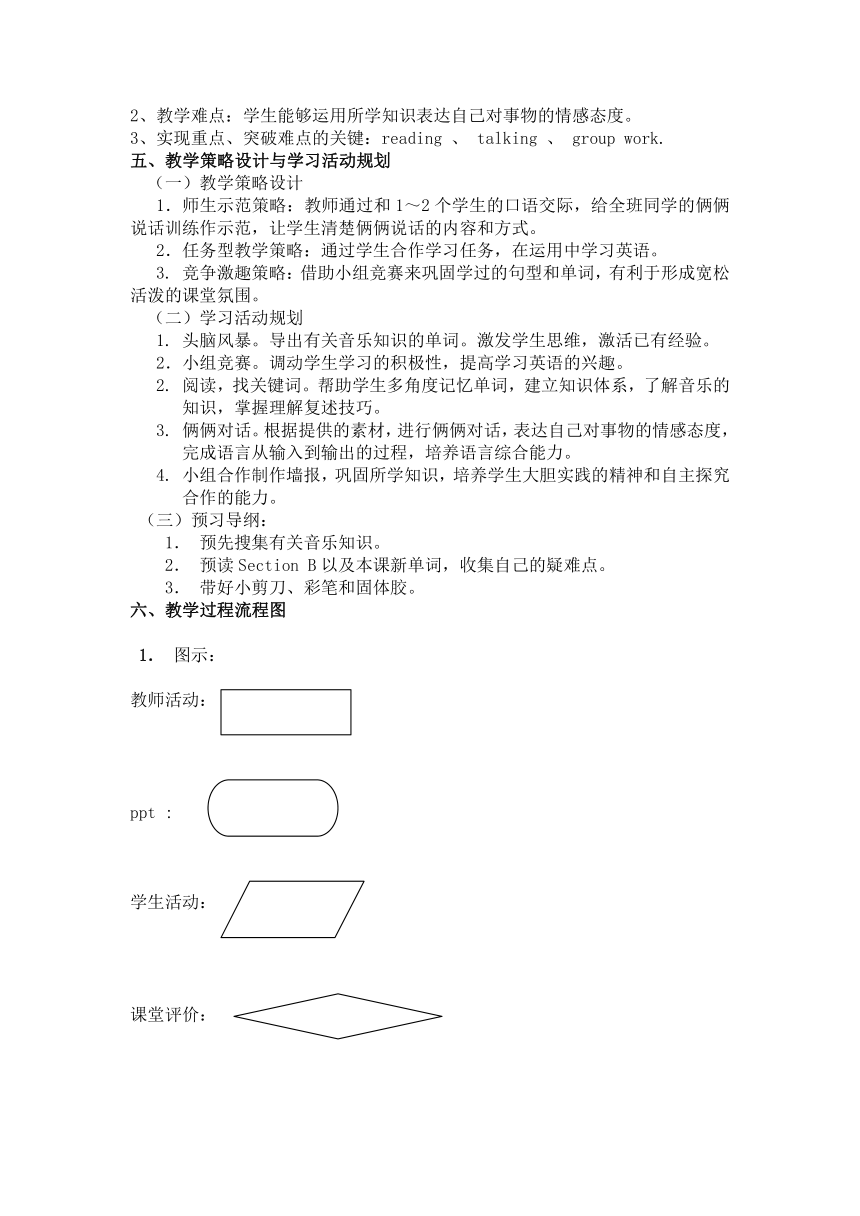仁爱科普版八年级上册 Unit 3 Topic 2 What sweet music!Section B 教案
文档属性
| 名称 | 仁爱科普版八年级上册 Unit 3 Topic 2 What sweet music!Section B 教案 |  | |
| 格式 | doc | ||
| 文件大小 | 80.5KB | ||
| 资源类型 | 教案 | ||
| 版本资源 | 仁爱科普版 | ||
| 科目 | 英语 | ||
| 更新时间 | 2022-10-15 18:49:47 | ||
图片预览



文档简介
仁爱英语八年级Unit3Topic2 SectionB教学设计
一、概述
本课是义务教育课程标准实验教科书仁爱版八年级Unit3 Topic2 Section B,是本话题的第二课,所需课时为1课时。本课时主要教会学生找关键词,帮助学生利用关键词复述3a以及通过1a的学习学会表达自己对事物的情感态度,主要句型是:It is not my favorite, but I don’t mind it. I hate to listen to….本课主要基于学生已有的经验,联系学生所学知识,通过competition, dialogues、readings、pair work, group work等多种活动,复习旧知,联系新知,丰富学生的词句,训练学生的说听写的综合能力,提高学生的语言运用能力。并在活动中学会自主探究合作性学习。
二、教学目标分析
1.知识和技能目标
(1)掌握单词everyday, simple, be famous for…,be popular with…,能够做到发音准确、清晰,拼写正确。
(2)学会关于情感态度的表达法,熟悉句型It is not my favorite, but I don’t mind it. I hate to listen to…,并能运用该句型谈论自己的喜恶。
(3)了解音乐的分类,歌手等,学会找阅读材料中的关键词,并利用关键词进行复述。
(4)能够根据所学知识制作墙报,能够进行自主探究合作性学习。
2.过程与方法
(1)通过预习导纲,引导学生课前预习,收集有关音乐的知识。通过头脑风暴法,激发已有经验,为新知识的学习做好准备。
(2)借助教师弹奏的乐曲作引入,学生能够通过例句接触新词,进而记忆和理解本课知识目标。
(3)通过教师示范共同学习如何寻找关键词,学生能够获得快速寻找关键词,并根据关键词复述文章的技能。
(4)通过俩俩对话和小组合作学习,学生能够灵活运用所学新知识。
3.情感目标
培养学生敢于用英语表达自己的看法和大胆实践的精神,鼓励学生拥有健康的兴趣爱好。
三、学习者特征分析
1. 本节课的教学对象是东侨中学初二(2)班的学生。
2. 学生能够熟练掌握关于喜欢的表达。
3. 学生思维活跃,阅读的兴趣和表达的愿望比较强烈;
4. 学生对音乐这个话题非常感兴趣。
5.学生对ppt的呈现方式十分好奇。
6. 学生好胜心强,喜欢竞赛。
7. 学生的逻辑思维能力欠强,需要及时引导学生进行归纳、总结。
四、确定教学任务
1、教学重点:
(1)掌握单词:everyday, simple, be famous for…,be popular with….
(2)掌握对事物的情感态度的表达法及句型It is not my favorite, but I don’t mind it. I hate to listen to ….
2、教学难点:学生能够运用所学知识表达自己对事物的情感态度。
3、实现重点、突破难点的关键:reading 、 talking 、 group work.
五、教学策略设计与学习活动规划
(一)教学策略设计
1.师生示范策略:教师通过和1~2个学生的口语交际,给全班同学的俩俩说话训练作示范,让学生清楚俩俩说话的内容和方式。
2.任务型教学策略:通过学生合作学习任务,在运用中学习英语。
3. 竞争激趣策略:借助小组竞赛来巩固学过的句型和单词,有利于形成宽松活泼的课堂氛围。
(二)学习活动规划
1. 头脑风暴。导出有关音乐知识的单词。激发学生思维,激活已有经验。
2.小组竞赛。调动学生学习的积极性,提高学习英语的兴趣。
2. 阅读,找关键词。帮助学生多角度记忆单词,建立知识体系,了解音乐的知识,掌握理解复述技巧。
3. 俩俩对话。根据提供的素材,进行俩俩对话,表达自己对事物的情感态度,完成语言从输入到输出的过程,培养语言综合能力。
4. 小组合作制作墙报,巩固所学知识,培养学生大胆实践的精神和自主探究合作的能力。
(三)预习导纲:
1. 预先搜集有关音乐知识。
2. 预读Section B以及本课新单词,收集自己的疑难点。
3. 带好小剪刀、彩笔和固体胶。
六、教学过程流程图
1. 图示:
教师活动:
ppt :
学生活动:
课堂评价:
2. 流程图:
七、教学过程
Step 1 Review and Lead in 第一步 复习与导入 (时间:4分钟)
Greetings
Brainstorming
T:You collected something about music yesterday. Now let’s have a competition to see which group has got more information. Only 2 minutes for you.
T:Time’s up! Group X is the winner. Congratulations! I’m glad to know that you know so much about music. Now I will play the piano. Can you guess what music I am playing
教师弹奏音乐。学生猜。
T: what kind of music is it
Ss: …
T: It is classical music. (板书classical) Do you know who wrote it
Ss: 贝多芬
T: Yes, Beethoven wrote it. And Beethoven is famous for it. (板书:be famous for)
Do you know “be famous for” For example, China is famous for the Great Wall. Do you want to know more about classical music
Step 2 Reading 第二步 阅读(时间:10分钟)
1. Learn to find key words and retell
T: Here is a passage about it. (呈现幻灯1:passage about classical music.) After reading the passage I have several questions for you. Now let’s read it together.
Ss: (Read)
T: Now have you got anything more about classical music Can you answer these questions (呈现问题)
Q1: What is classical music like
Q2: Where can we enjoy classical music
Q3: Who are famous for the classical music (答案直接在passage中呈现)
T: These words tell us some important information about classical music. They are key words.
They tell us “what, where, who, and …” “and when and how” Got it Do you know how to find them Let’s have a try. Now open your books to page 64. Let’s read something more about other kinds of music, and try to find out their key words. (学生寻找关键词,教师相机指导。
2 minutes later,学生汇报。汇报完毕,教师呈现幻灯2:关键词。给出评价。)
T: Pay attention to the red words. They are new words. Let’s read them together. (带领学生整体朗读红色单词。)Do you have any difficulties
(引导学生解决疑难点)
T:Now let’s look at the key words here. We can use the key words to help us retell the passage. (和学生一起复述第一自然段。)Now can you retell the rest two parts by yourselves? Two minutes for you to get ready. Please!
Two minutes later,学生复述,适当评价。
Step 3 Look, listen and say 第三步 看听说(时间:20分钟)
1. Look, listen and say
T: Wen Wei and Jane are talking about music, too. Let’s go and join them. First, listen to the dialogue and finish the tasks. (呈现幻灯3,和学生一起学习问题后播放音频,听录音一遍完成连线题)
T: Well, this time open your books to page 63. Read 1a to finish 1b. Please!
(Check the answers. 解决疑难点)
T: Now let’s read after the video.
T: Now Group I is Jane, and Group II is Wen Wei. Let’s read it again.
2. Pair works
T: Good! Now practice 1a in pairs. (一组学生汇报,教师予以评价。)
T: Well now let’s find out the sentences about their likes and dislikes in the passage.(表示喜欢和不喜欢的句子) (学生说,教师板书句型 It’s hard to say. /I used to enjoy pop music, but now I like …/ … is my favourite, but I don’t like mind it. / I don’t like it at all.)Can we show our feelings in other ways (继续板书)
T: Here are some useful expressions for you. 呈现幻灯4. Pay attention to “hate to”.
T: Well. Now let’s listen to some pieces of music and talk about them with these expressions.
【拓展:talk about sports 出示幻灯明确任务。】
T: Now let’s talk about something else. Make conversations similar to 1a. For example, we can talk about sports such as basketball, soccer and table tennis, etc. Work in pairs. Please!
Step 4 Project 第四步 探究活动 (时间:10分钟)
Group work
(播放轻音乐,让学生在轻松愉悦的氛围下完成)
T:Everybody has done a very good job. In this class, we share some information about music and we know how to talk about our likes and dislikes. Can you also make your own newspapers
(现在八个同学一个小组合作完成一张手抄报。两个同学给自己小组命名,讨论设计出小组的标志,并负责展示本组作品。一个同学负责刊头、版面设计和插图,五个同学负责编辑采写内容,内容可以是你们昨天收集到的音乐信息,可以是我们本节课所学的内容,还可以是你们喜欢的歌曲或者音乐会信息。你们先开始分工,现在我分发材料。看哪个小组做得又快又好。)
(学生动手,教师相机指导,通过激励性语言来刺激学生,调动气氛。最后展示。没做完的小组,课后完成。第二天带来分享。)
板书设计
What sweet music!Section BLike Just so–so DislikeI like pop music best. Classical music is not my favorite, I hate to listen to rock music.but I don’t mind it.It’s hard to say.I used to enjoy pop music, but now I like folk music.like … best……
头脑风暴小组竞赛
阅读,找关键词
跟读,role play
组织教学
教师提示,引导思路
激活经验
相机指导
独立找关键词
Passage about classical music Key words
1a 音频
背景音乐
个别教学并隐形分层教学
表达情感态度
听1a,回答问题
是
否
是
小组合作,制作墙报
否
否
组织活动
Pair work
Useful expressions
钢琴软件
1a 动画
PAGE
一、概述
本课是义务教育课程标准实验教科书仁爱版八年级Unit3 Topic2 Section B,是本话题的第二课,所需课时为1课时。本课时主要教会学生找关键词,帮助学生利用关键词复述3a以及通过1a的学习学会表达自己对事物的情感态度,主要句型是:It is not my favorite, but I don’t mind it. I hate to listen to….本课主要基于学生已有的经验,联系学生所学知识,通过competition, dialogues、readings、pair work, group work等多种活动,复习旧知,联系新知,丰富学生的词句,训练学生的说听写的综合能力,提高学生的语言运用能力。并在活动中学会自主探究合作性学习。
二、教学目标分析
1.知识和技能目标
(1)掌握单词everyday, simple, be famous for…,be popular with…,能够做到发音准确、清晰,拼写正确。
(2)学会关于情感态度的表达法,熟悉句型It is not my favorite, but I don’t mind it. I hate to listen to…,并能运用该句型谈论自己的喜恶。
(3)了解音乐的分类,歌手等,学会找阅读材料中的关键词,并利用关键词进行复述。
(4)能够根据所学知识制作墙报,能够进行自主探究合作性学习。
2.过程与方法
(1)通过预习导纲,引导学生课前预习,收集有关音乐的知识。通过头脑风暴法,激发已有经验,为新知识的学习做好准备。
(2)借助教师弹奏的乐曲作引入,学生能够通过例句接触新词,进而记忆和理解本课知识目标。
(3)通过教师示范共同学习如何寻找关键词,学生能够获得快速寻找关键词,并根据关键词复述文章的技能。
(4)通过俩俩对话和小组合作学习,学生能够灵活运用所学新知识。
3.情感目标
培养学生敢于用英语表达自己的看法和大胆实践的精神,鼓励学生拥有健康的兴趣爱好。
三、学习者特征分析
1. 本节课的教学对象是东侨中学初二(2)班的学生。
2. 学生能够熟练掌握关于喜欢的表达。
3. 学生思维活跃,阅读的兴趣和表达的愿望比较强烈;
4. 学生对音乐这个话题非常感兴趣。
5.学生对ppt的呈现方式十分好奇。
6. 学生好胜心强,喜欢竞赛。
7. 学生的逻辑思维能力欠强,需要及时引导学生进行归纳、总结。
四、确定教学任务
1、教学重点:
(1)掌握单词:everyday, simple, be famous for…,be popular with….
(2)掌握对事物的情感态度的表达法及句型It is not my favorite, but I don’t mind it. I hate to listen to ….
2、教学难点:学生能够运用所学知识表达自己对事物的情感态度。
3、实现重点、突破难点的关键:reading 、 talking 、 group work.
五、教学策略设计与学习活动规划
(一)教学策略设计
1.师生示范策略:教师通过和1~2个学生的口语交际,给全班同学的俩俩说话训练作示范,让学生清楚俩俩说话的内容和方式。
2.任务型教学策略:通过学生合作学习任务,在运用中学习英语。
3. 竞争激趣策略:借助小组竞赛来巩固学过的句型和单词,有利于形成宽松活泼的课堂氛围。
(二)学习活动规划
1. 头脑风暴。导出有关音乐知识的单词。激发学生思维,激活已有经验。
2.小组竞赛。调动学生学习的积极性,提高学习英语的兴趣。
2. 阅读,找关键词。帮助学生多角度记忆单词,建立知识体系,了解音乐的知识,掌握理解复述技巧。
3. 俩俩对话。根据提供的素材,进行俩俩对话,表达自己对事物的情感态度,完成语言从输入到输出的过程,培养语言综合能力。
4. 小组合作制作墙报,巩固所学知识,培养学生大胆实践的精神和自主探究合作的能力。
(三)预习导纲:
1. 预先搜集有关音乐知识。
2. 预读Section B以及本课新单词,收集自己的疑难点。
3. 带好小剪刀、彩笔和固体胶。
六、教学过程流程图
1. 图示:
教师活动:
ppt :
学生活动:
课堂评价:
2. 流程图:
七、教学过程
Step 1 Review and Lead in 第一步 复习与导入 (时间:4分钟)
Greetings
Brainstorming
T:You collected something about music yesterday. Now let’s have a competition to see which group has got more information. Only 2 minutes for you.
T:Time’s up! Group X is the winner. Congratulations! I’m glad to know that you know so much about music. Now I will play the piano. Can you guess what music I am playing
教师弹奏音乐。学生猜。
T: what kind of music is it
Ss: …
T: It is classical music. (板书classical) Do you know who wrote it
Ss: 贝多芬
T: Yes, Beethoven wrote it. And Beethoven is famous for it. (板书:be famous for)
Do you know “be famous for” For example, China is famous for the Great Wall. Do you want to know more about classical music
Step 2 Reading 第二步 阅读(时间:10分钟)
1. Learn to find key words and retell
T: Here is a passage about it. (呈现幻灯1:passage about classical music.) After reading the passage I have several questions for you. Now let’s read it together.
Ss: (Read)
T: Now have you got anything more about classical music Can you answer these questions (呈现问题)
Q1: What is classical music like
Q2: Where can we enjoy classical music
Q3: Who are famous for the classical music (答案直接在passage中呈现)
T: These words tell us some important information about classical music. They are key words.
They tell us “what, where, who, and …” “and when and how” Got it Do you know how to find them Let’s have a try. Now open your books to page 64. Let’s read something more about other kinds of music, and try to find out their key words. (学生寻找关键词,教师相机指导。
2 minutes later,学生汇报。汇报完毕,教师呈现幻灯2:关键词。给出评价。)
T: Pay attention to the red words. They are new words. Let’s read them together. (带领学生整体朗读红色单词。)Do you have any difficulties
(引导学生解决疑难点)
T:Now let’s look at the key words here. We can use the key words to help us retell the passage. (和学生一起复述第一自然段。)Now can you retell the rest two parts by yourselves? Two minutes for you to get ready. Please!
Two minutes later,学生复述,适当评价。
Step 3 Look, listen and say 第三步 看听说(时间:20分钟)
1. Look, listen and say
T: Wen Wei and Jane are talking about music, too. Let’s go and join them. First, listen to the dialogue and finish the tasks. (呈现幻灯3,和学生一起学习问题后播放音频,听录音一遍完成连线题)
T: Well, this time open your books to page 63. Read 1a to finish 1b. Please!
(Check the answers. 解决疑难点)
T: Now let’s read after the video.
T: Now Group I is Jane, and Group II is Wen Wei. Let’s read it again.
2. Pair works
T: Good! Now practice 1a in pairs. (一组学生汇报,教师予以评价。)
T: Well now let’s find out the sentences about their likes and dislikes in the passage.(表示喜欢和不喜欢的句子) (学生说,教师板书句型 It’s hard to say. /I used to enjoy pop music, but now I like …/ … is my favourite, but I don’t like mind it. / I don’t like it at all.)Can we show our feelings in other ways (继续板书)
T: Here are some useful expressions for you. 呈现幻灯4. Pay attention to “hate to”.
T: Well. Now let’s listen to some pieces of music and talk about them with these expressions.
【拓展:talk about sports 出示幻灯明确任务。】
T: Now let’s talk about something else. Make conversations similar to 1a. For example, we can talk about sports such as basketball, soccer and table tennis, etc. Work in pairs. Please!
Step 4 Project 第四步 探究活动 (时间:10分钟)
Group work
(播放轻音乐,让学生在轻松愉悦的氛围下完成)
T:Everybody has done a very good job. In this class, we share some information about music and we know how to talk about our likes and dislikes. Can you also make your own newspapers
(现在八个同学一个小组合作完成一张手抄报。两个同学给自己小组命名,讨论设计出小组的标志,并负责展示本组作品。一个同学负责刊头、版面设计和插图,五个同学负责编辑采写内容,内容可以是你们昨天收集到的音乐信息,可以是我们本节课所学的内容,还可以是你们喜欢的歌曲或者音乐会信息。你们先开始分工,现在我分发材料。看哪个小组做得又快又好。)
(学生动手,教师相机指导,通过激励性语言来刺激学生,调动气氛。最后展示。没做完的小组,课后完成。第二天带来分享。)
板书设计
What sweet music!Section BLike Just so–so DislikeI like pop music best. Classical music is not my favorite, I hate to listen to rock music.but I don’t mind it.It’s hard to say.I used to enjoy pop music, but now I like folk music.like … best……
头脑风暴小组竞赛
阅读,找关键词
跟读,role play
组织教学
教师提示,引导思路
激活经验
相机指导
独立找关键词
Passage about classical music Key words
1a 音频
背景音乐
个别教学并隐形分层教学
表达情感态度
听1a,回答问题
是
否
是
小组合作,制作墙报
否
否
组织活动
Pair work
Useful expressions
钢琴软件
1a 动画
PAGE
同课章节目录
- Unit 1 Playing Sports
- Topic 1 I'm going to play basketball.
- Topic 2 I'll kick you the ball again.
- Topic 3 The school sports meet is coming.
- Unit 2 Keeping Healthy
- Topic 1 You should brush your teeth twice a day.
- Topic 2 I must ask him to give up smoking.
- Topic 3 Must we exercise to prevent the flu?
- Unit 3 Our Hobbies
- Topic 1 What's your hobby?
- Topic 2 What sweet music!
- Topic 3 What were you doing at this time yesterday
- Unit 4 Our World
- Topic 1 What's the strongest animal on the farm?
- Topic 2 How can we protect ourselves from the eart
- Topic 3 The Internet makes the world smaller.
